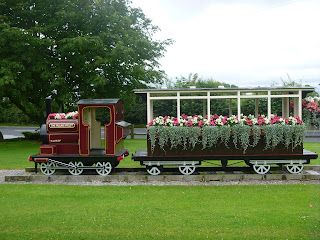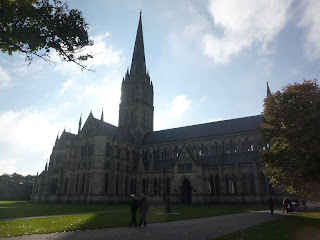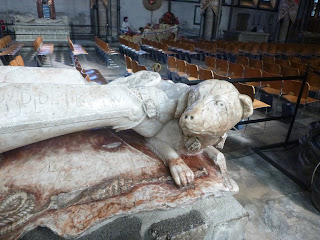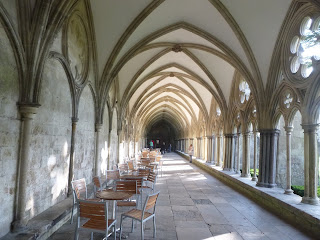High Five.......
I decided to reminisce on our trip by picking my top 5 sights or experiences from the British Isles.Leaving aside the visits to family and friends, (that are always the best part of our trips), I came up with the following list:
Number 5 - London's Pride
Some of you may have heard of London, a small metropolis in the south of England. London is known to the international traveller and connoisseur for several reasons, one as being the country residence of a strange Germano-Greek, disfunctional family, who are accustomed to the locals worshipping them and singing anthems entreating god to save them. Funnily enough, our Prime Minister, the beloved John Key, (long may he rule in magnificent splendour), spends a fair part of his time kissing their nether regions and grovelling obsequiously.In London, you can eat like a king if you can afford it but more commonly, the English feast on fried potatoes, fish or fish alternative, (i.e. pies with gravy).
Pies with fried potatoes on the one plate and mashed potatoes on the other. Who really cares as long as they're spuds? Since the proliferation of reality TV chef programmes, food like this is becoming hard to find. I expect that this cafe will be awarded a Michelin star in the near future, largely because of its rarity value.
More proof of the healthy eating that abounds in this island, on this low-cal menu. Don't be fooled by the "Beef Burger and Salad" though, as the salad was merely a lettuce leaf on the burger bun.
Other strange phenomena can also be sighted in London, such as this pink garbed contortionist, spotted in a London backstreet gym!
Whether she's beseeching the lord or praying to Mecca we'll never know, (although right now she's threatening to disembowel me).
Number 4 - The Pilling Pig
This well known tourist attraction is located at Pilling, near Blackpool in Lancashire. Tens of people from all over the village visit this technological marvel every year and stare in awe at the latest development in low-speed rail.
This little engine, (which is a real Tank Engine, unlike Thomas), used to roam the railway track between Knott End and Garstang, in the days of yore. It's called the Pilling Pig because its whistle was reminiscent of the noise a pig makes when its throat is being cut!
The trains around this part of the world breed! Here's the proof - the Pilling Piglet.
Number 3 - English Wildlife
Contrary to the general opinion that most English wildlife is to be found around and inside the country's football grounds and public houses, there are some wild and dangerous beasties lurking in stream and hedgerows throughout the land.
Make the slightest move towards these vicious ducklings and they will mob you until you feed them half a loaf. No bread? Well be prepared to be pecked to death!
A Mute Swan! These creatures are not actually mute, so why they are so named? I don't know. It is commonly said that a blow from a swan's wing could break your leg or even kill a child. Unfortunately, there were no children around to test the theory.
The "Killer Sheep of Shap", roaming wild on Shap Moor. Those of you who think that these aren't dangerous haven't been watching enough Monty Python movies.
Number 2 - Carnival Time
No, not the Notting Hill Carnival but a real one that has been held for centuries in Carnforth, (well since the 1960's anyway). The purpose of this carnival is to provide annual evidence that village idiots still abound. Some people had advanced a theory, that since I left Carnforth in the 1960's, the village had lost its idiot, never to be replaced.
However, the photographic evidence gives plenty of proof that the supply of candidates, (for village idiot), is unlimited, for how else can you explain that the whole village took time out for a carnival of such stupefying ordinariness.
The "Sports Queen" with a wave that would do QE II justice. Her beauty was somewhat overshadowed by the attendants in high-viz jackets though! For a brief moment, I thought that she was going to be mobbed by the adoring audience, but British restraint and good manners took over at the very last moment.
This is a very tricky one, (something like where's Wally), but there is one person on this float not in fancy dress! I'm not a hundred percent sure but I think it's the goggle-eyed one on the extreme left of the float.
And finally, proof, (if you needed it), that the Greenlands continue their village idiot connections.
Number 1 - In an English Country Garden
“Our England is a garden, and such gardens are not made By singing - 'Oh how beautiful!' and sitting in the shade". - Rudyard Kipling.
Whenever you want a quintessentially English quote, there's always good old Rudyard!
The summer flowers and trees were typically lush and abundant.
On Crags!
In Hedgerows
And even in gardens.
Or even in a Coronation Street garden, (complete with peeping tom)!





























































